Verdict
The Pixel 7 offers a charming and impressive all-round experience, with a particularly impressive camera system, making it very good value for its asking price.
Pros
- Great camera
- Good screen
- Stylish design
Cons
- Few upgrades from the Pixel 6
- No telephoto camera
- Slow charging
-
Dual camera systemThe Pixel 7 has a similar dual-sensor set-up to the highly-rated Pixel 6 -
Unique designThis handset’s appearance, and especially the metallic camera bar, is likely to turn heads -
Android 13This is one of the first handsets to run Google’s latest operating system out of the box
Introduction
The Pixel 6 line marked a quantum shift for Google’s own range of smartphones, representing the first time that the tech giant had made a genuine, all-out flagship. But it’s a different story with the Pixel 7.
It’s not possible for this follow-up to raise the standards in quite the same way, but you’re entitled to expect a yearly upgrade; nonetheless, a glance at the specs sheet seems to show very modest changes indeed, and even a slightly smaller screen and battery,
Yet despite the lack of many major hardware upgrades over its predecessor, does the Pixel 7 still deliver the goods where it matters with both its hardware and its software, and would it make a good upgrade for you?
Design and Screen
- Suave-looking design
- Clunky camera bar
- IP68 water resistance
- Good quality screen
Just as a high-performing camera is a signature of the Pixel range, so is an eye-catching design. This generation has seen a significant makeover from its predecessors, with a nice shiny metallic camera bar now replacing the somewhat characterless black bar of the Pixel 6. The glossy back panel both looks and feels highly attractive, available in a trinity of alluring colours (Obsidian, Lemongrass, Snow) while feeling very smooth to the touch.
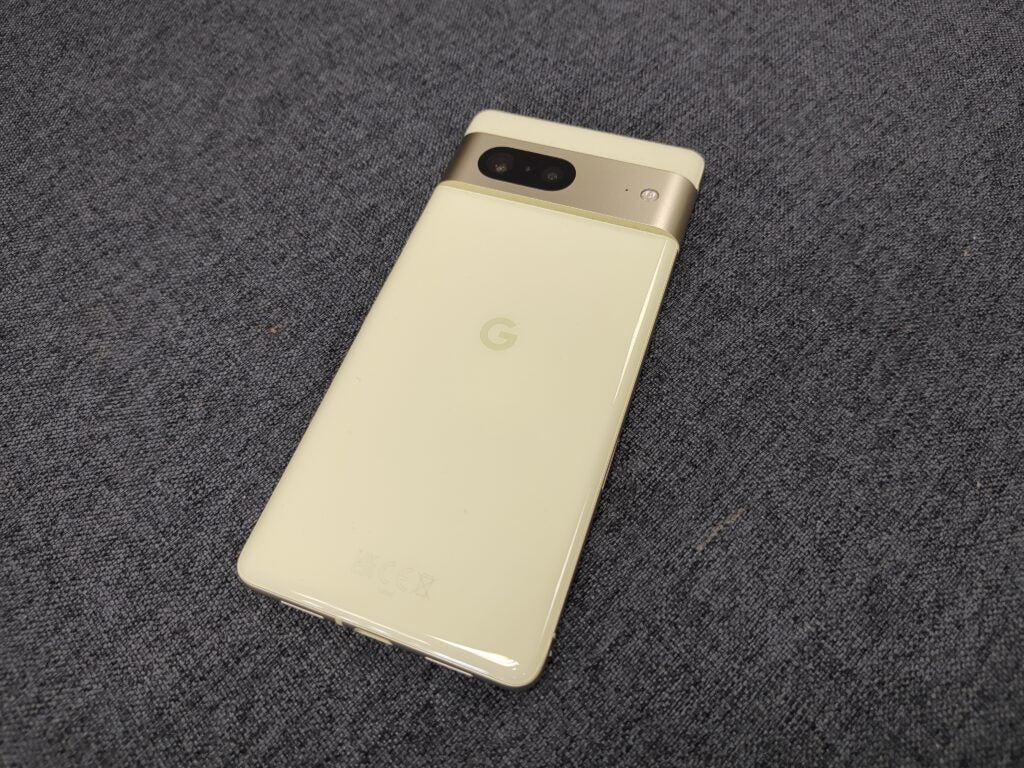
However, whilst it certainly looks good, I did feel annoyed by the camera bar in general, precisely because of its perpendicular edges. While many other phones have a smooth bump to the camera module (best exemplified by the Oppo Find X5 Pro), this one has corners that are so geometric as to be almost sharp.
It makes it a tad less comfortable to hold, it collects small traces of dust in the corners which detract from the visual appeal, and I found it can even snag on jean pockets when you’re taking your phone out. Therefore while the Pixel 7 certainly does look good, I think it could have done with a bit more thought into its ergonomics.
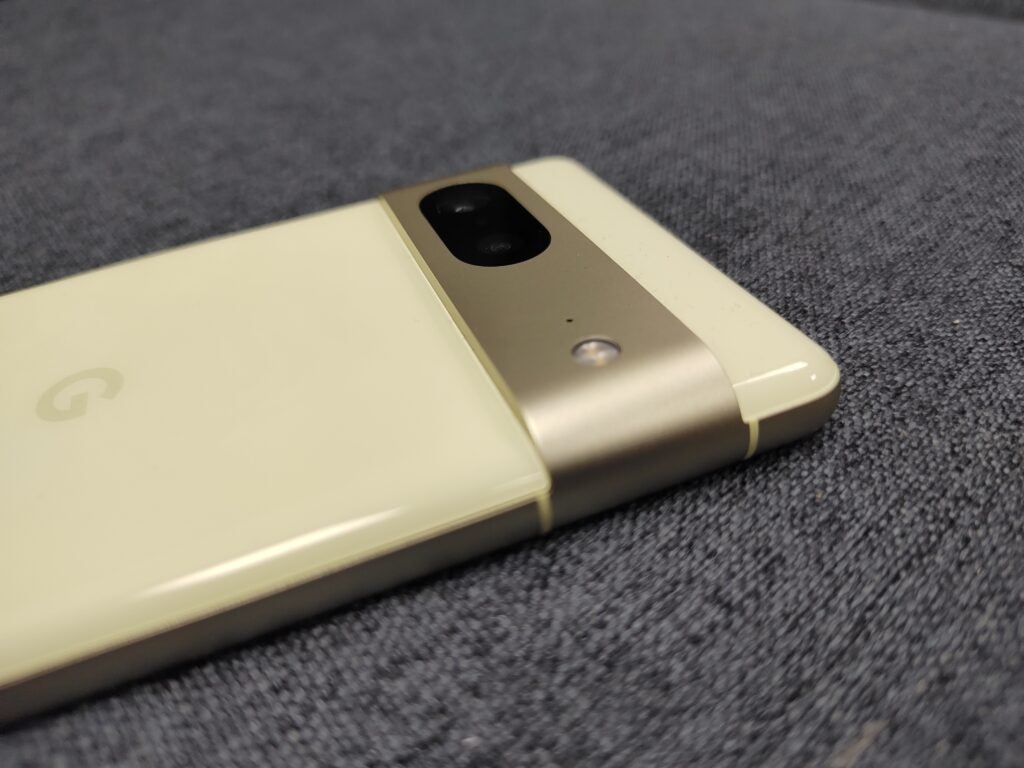
Another slight grumble along these lines in the positioning of the power and volume buttons. On most phones, you find these nearer the top and the bottom respectively, but this phone reverses the order and so can take a little getting used to; for the first few weeks of using it, you might accidentally blow out your eardrums when trying to switch off the screen, or turn off a video when you’re trying to hear what someone is saying.
You also won’t get any handy little “optional extras” as far as hardware is concerned; no 3.5mm headphone jack, no SD card tray, and no physical dual SIM capability (though there is eSIM support). None of these are particularly surprising though, as Pixels left these features behind a while ago.
Fortunately though, the Pixel 7 is a robust device. It’s got an IP68 rating, so it is well protected against water and dust, and it’s also constructed from Gorilla Glass Victus on the front and the back, so will not be prone to scratching or cracking.
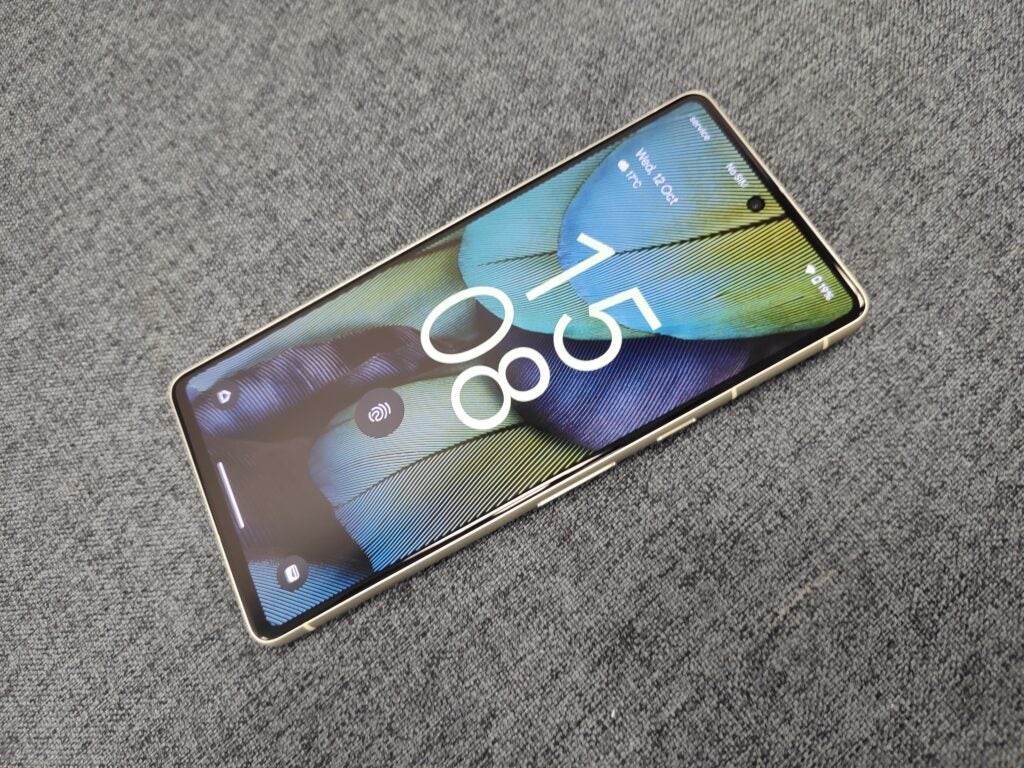
The AMOLED screen measures 6.3-inches and therefore is a touch larger than the Samsung Galaxy S22 (at 6.1-inches and the iPhone 14 (6.1-inches) but it remains very easy to use with one hand, and the display is still plenty big enough to watch videos on and use your apps as normal.
The resolution of 1080×2400 is sharp at this size, the contrast is very strong thanks to its AMOLED tech, and it’s bright enough to be able to be read under direct sunlight.
One slight potential shortcoming is that its maximum refresh rate is capped at 90Hz, while many rivals, including the Pixel 7 Pro, have reached a refresh rate of 120Hz; this means that it is less smooth when you’re scrolling, as the display renews itself significantly fewer times per second. In practice, I found that the screen was more than smooth enough.
I certainly found the screen to be detailed and punchy, and while you might want a larger panel if you’re watching a lot of videos or playing a lot of games – and you might particularly want a higher refresh rate if you’re keen on the latter – I think that most users will be more than satisfied with the screen’s good qualities.
Camera
- 50-megapixel main camera
- 13-megapixel ultrawide
- No telephoto lens
- Excellent photos overall
Of course, the starring feature of Google’s Pixel phones is typically its camera. These handsets are often seen as the key Android camera players, perhaps even eclipsing Samsung, so the pressure is on to see whether the Pixel 7 can keep up those lofty standards.
The camera system here seems highly similar to that of the Pixel 6, at least on the rear where you’ll once again find a 50-megapixel main camera and a 13-megapixel ultrawide lens (with a telephoto lens being reserved for the more expensive Pixel 7 Pro). On the front there’s a new selfie camera with a 10.8-megapixel resolution, meaning that it’s now capable of shooting 4K footage.
I’m pleased to say that I was certainly very happy with the camera during my time using it, across various different lighting conditions.
Images taken with the Pixel’s rear cameras can at times be jaw-droppingly good; punchy yet not unnaturally vivid, highly detailed, and versatile enough to give you a few different shooting options. Friends noted at the quality of the pictures, even those who are not particularly into photography.
Below is a selection of shots from the main camera, including close-ups of food, and portrait shots, to show its quality and versatility:
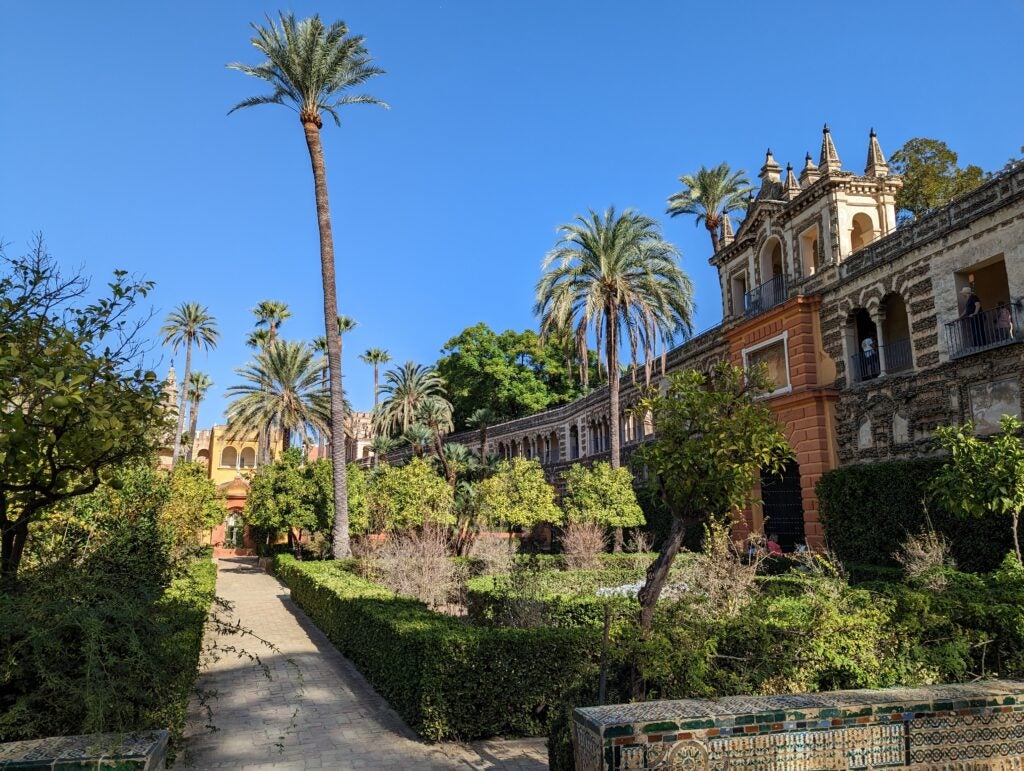
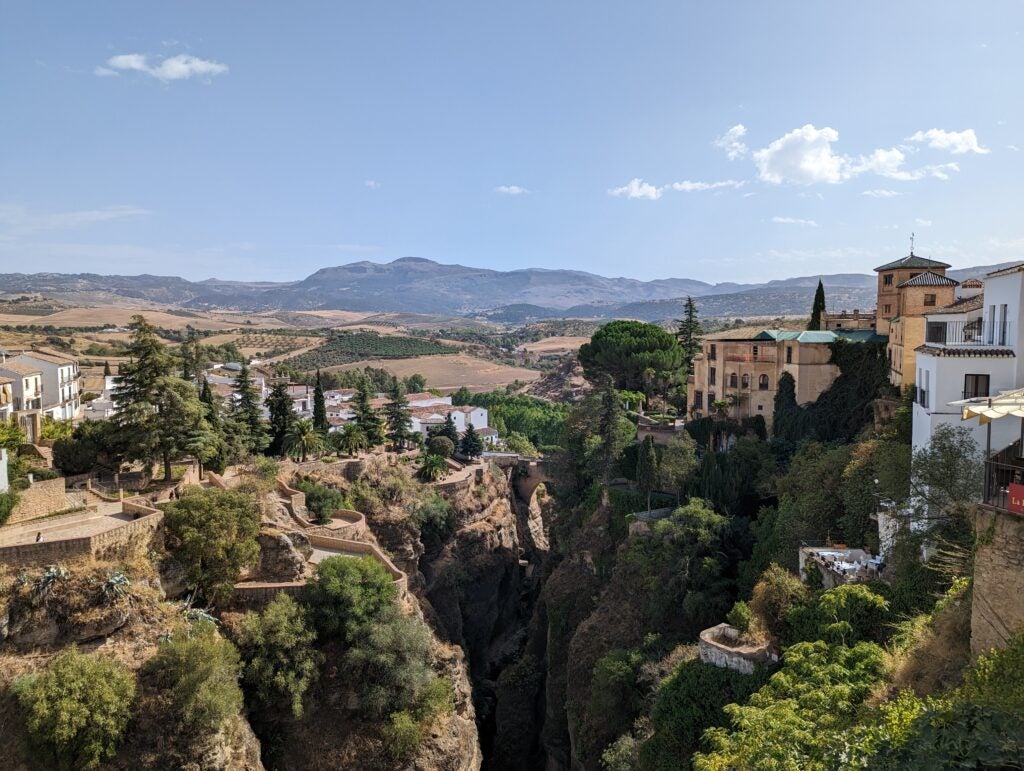


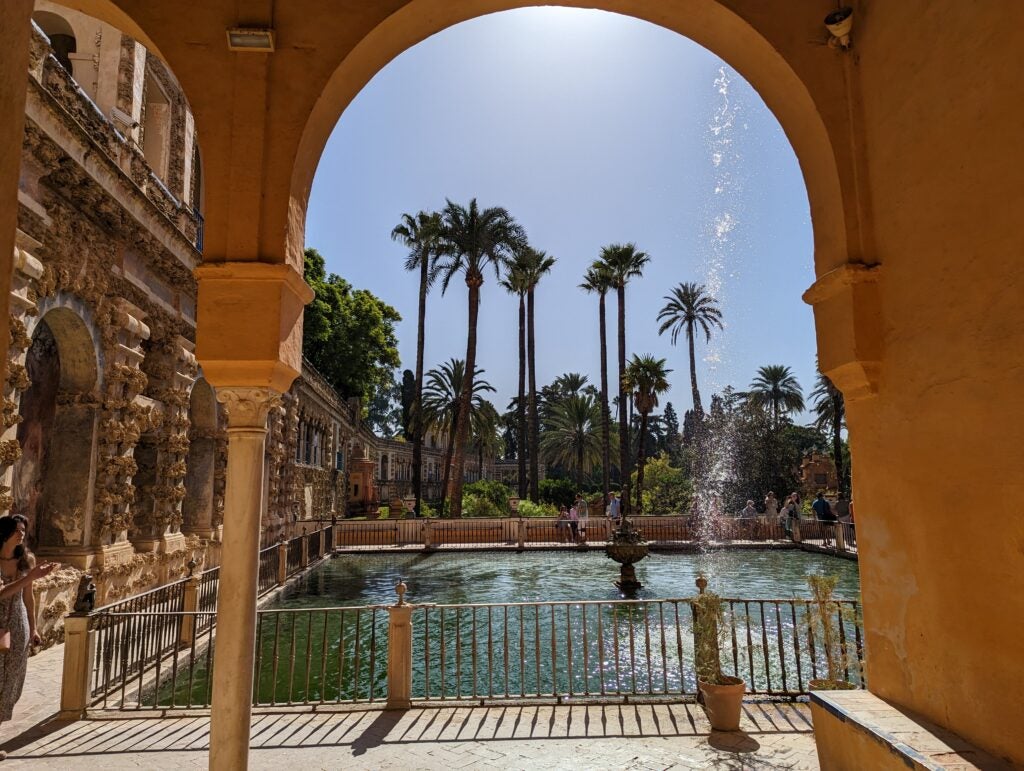
Some of the above pictures were taken under very strong sunlight yet did not appear washed out (though there was occasionally some lens flare), and this quality held up under darker conditions as well, with colour being restored to the image effectively but not overwhelming it:


The ultrawide sensor (which took the image directly above) packed some extra versatility into the package, letting you squeeze more into the frame, which was particularly useful when in mountainous regions and trying to give some idea of the scale of the surrounding scenery, or if trying to shoot a large looming building:

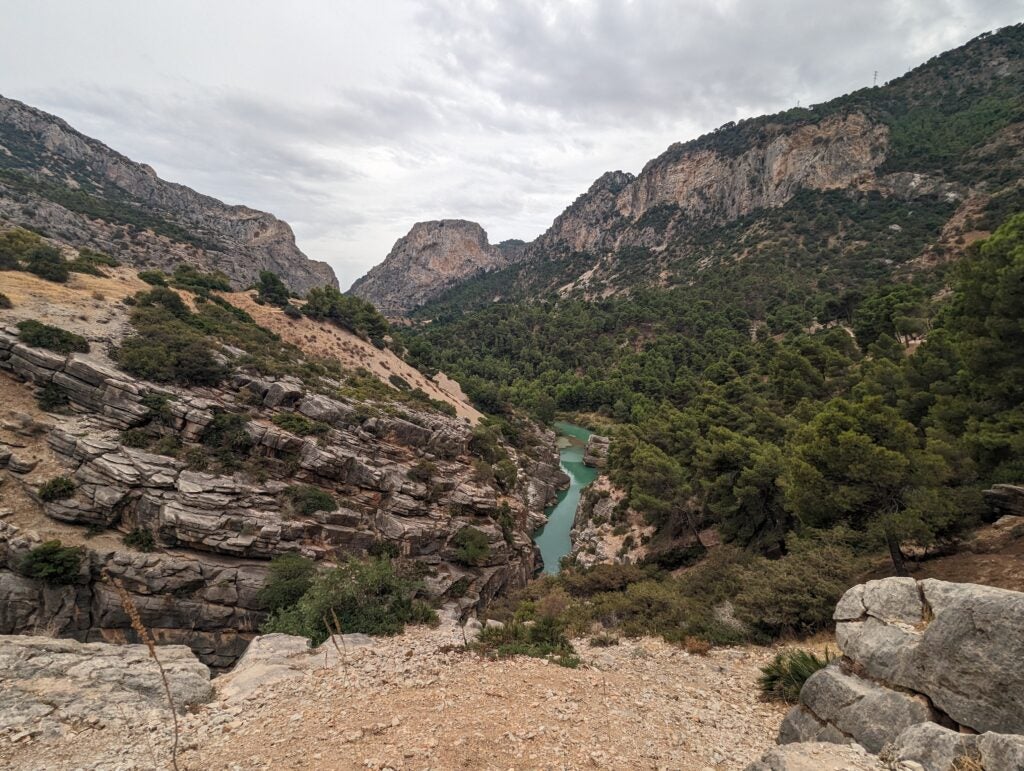
As you can see, while these images were taken with a lower resolution sensor than the main one, they still remain impressively detailed.
There’s no dedicated telephoto sensor on board this phone, so if you want to zoom a little closer to your subject then you’ll have to count on the digital zoom capabilities of the main sensor. Set by default to 2x, this still functions well; the below pictures were taken of the same bridge, from the same position using the ultrawide, main camera, and 2x digital zoom for a side-by-side comparison:
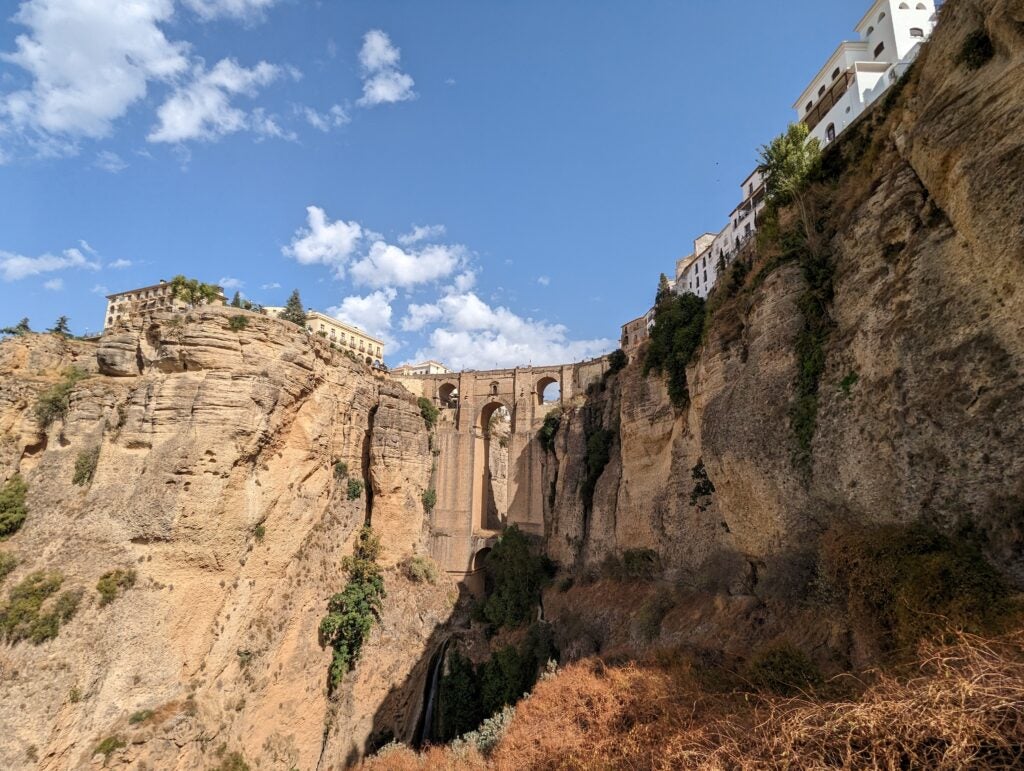


Selfie photos were also generally appealing, with sharp and punchy images that accurately reproduced the textures of skin and hair:

Finally, I was also very impressed with the video capture capabilities. Able to take 4K footage at 60 frames per second, the video we took with this phone on these settings (note that the default is 1080p @ 30fps) was very sharp and smooth.
Performance
- Good CPU and GPU performance
- Attractive and useful software
The Pixel 7 runs on a Tensor G2 chip. This is the sequel to the Tensor, which was Google’s first-ever own-brand mobile processor and made its debut on the Pixel 6.
In our review of that device, we noted that the chip didn’t pull up trees in terms of its CPU and GPU benchmarks, but that it did however still perform very well when it came to image processing and smart features. This seems to hold true for the Tensor G2’s performance as well.
The below scores show its CPU scores (according to Geekbench 5) and the GPU scores (according to 3DMark), compared to competing Android flagships:
As you can see, the CPU scores are very similar to those of the OnePlus 10T but fall behind the likes of the Samsung Galaxy S22, but the Wild Life GPU score is generally a step below its rivals. However, it maxed out on the Sling Shot tests, so there are no comparison scores available.
While performance overall was smooth and fluid, even when running demanding apps or multitasking, the phone did crash at one point – and this was actually when running that GPU benchmark test. Last year we encountered quite a few bugs when using the Pixel 6, but fortunately, these did not recur during my time using the Pixel 7.
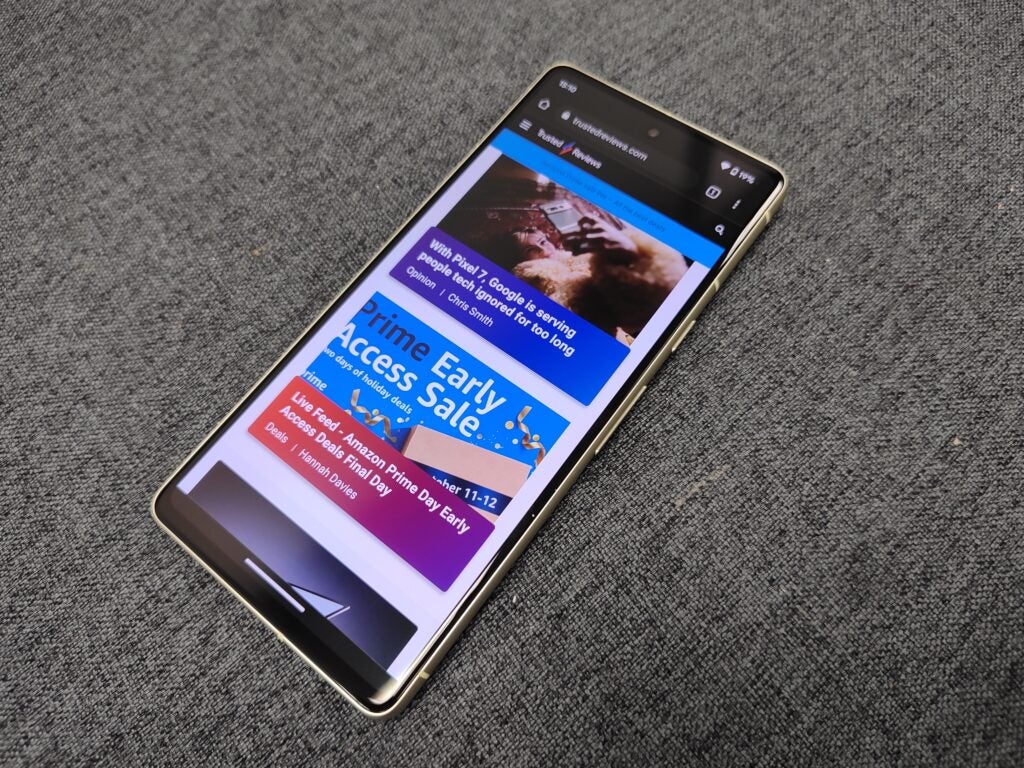
In fact, the light-touch software added to the pre-existing charm of the Pixel 7, and I enjoyed my time with it. You’ve got the familiar suite of Google apps here of course, and there’s little else besides.
While pre-installed voice recorder apps are rarely cause for celebration the Pixel’s one is particularly good, and can transcribe the sentences you speak into text; even though there were often some mistakes here and there in the transcript, it’s still a very helpful tool that allows you to search through recordings and write up the results much more easily.
Most of the software tricks, however, are reserved for the camera. Effects such as Magic Eraser mean you can quite effectively snip objects out of the frame if you don’t want them there (though this is best done for things in the background rather than the foreground), while Photo Unblur allows you to sharpen up images from your Google Photos library if there’s motion blurring. Again, this works best when you just need a subtle sharpening rather than a complete rehaul, but it’s a useful tool that does make some difference to previously underwhelming photos.
On top of these features, the Pixel 7 supports NFC, Bluetooth 5.2, and tri-band Wi-Fi, thereby offering good connectivity options.
Battery Life
- Good endurance
- Slow charging speeds
While most of us expect a few healthy upgrades from one phone generation to the next, in this case your hopes might seem to be dashed; while the Pixel 6 had a 4614mAh capacity, its successor offers just 4355mAh.
However, in my experience, this actually did deliver decent battery life over the course of the day, more so than I would have expected given the numbers on the spec sheet. This may be in part due to the efficiency of Google’s Adaptive Battery feature, which adjusts usage based on your activity with the phone, but I generally found that I could get a heavy day of use out of the phone without needing to worry about the battery when I got near the end of the day, which would usually finish around 20%.

On the other hand, I can’t be quite as positive about the charging speeds of this phone. There’s no charging brick included in the box for starters, so you’ll have to supply your own, and even when you do then you’ll have to make do with one that supplies 30W maximum. This will see the phone topped up in just over an hour, which is not so speedy by modern standards.
While this might not bother you too much, it does mean that you won’t be able to quickly top up the battery if, say, you’ve forgotten to charge it overnight. It’s not the biggest shortfall a phone can have, but fast charging is still a feature I usually appreciate and so I was a little underwhelmed by the speeds on offer here. Fortunately, at least the Pixel 7 does offer wireless charging and so adds convenience of a different kind.
Should you buy it?
This phone offers all-round excellence that’s likely to appeal to the vast majority of users, with the camera being a particular strength
If you’re most focused on mobile gaming or want a larger screen, there are better options elsewhere
Final Thoughts
The Pixel 7 is a very strong phone overall, with the camera being its most notable strength. While there are many other excellent handsets available to buy, often at extortionate prices, I wholeheartedly believe that this one is really worth the $599/£599 asking price, which is good value for photographic performance of this calibre, and its premium-looking and robust design also belies that rather more modest price tag.
That’s not to say that the device is without its faults, of course. The good-looking camera bar can sometimes be a little impractical, the charging speed lags behind many of its Android rivals, and it doesn’t have a telephoto camera or a 120Hz display refresh rate. That said, these all amount to fairly minor quibbles, that really shouldn’t be dealbreakers for the majority of buyers.
If you’re looking for a mid-range Android phone, and a good camera is your priority, it’s going to be very hard to look past the Pixel 7.
FAQs
Yes, as long as you’ve got a compatible SIM card and network coverage then you’ll be able to get 5G mobile data
The Google Pixel 7 has an IP68 rating
It’s available in Obsidian (Black), Snow (White), and Lemongrass (as pictured in the above review)
Jargon buster
IP68
The most popular and useful level of water resistance. Usually means a device can withstand dust, dirt and sand and be submerged in 1.5m of water for 30m however this can sometimes vary. Read more in our IP68 guide for more.
OLED
Organic Light Emitting Diode is panel technology that allows each individual pixel to produce light rather than relying on a backlight. This enables the screen to accurately display blacks by turning off the pixel, resulting in improved contrast compared to conventional LCD panels.
5G
Offering faster download and upload speeds when compared to 4G. Great for game streaming and HDR video playback. Not supported everywhere yet and speeds vary wildly.















